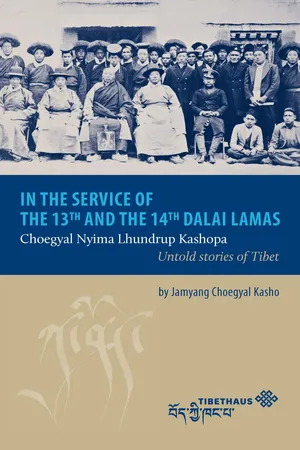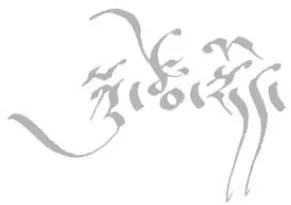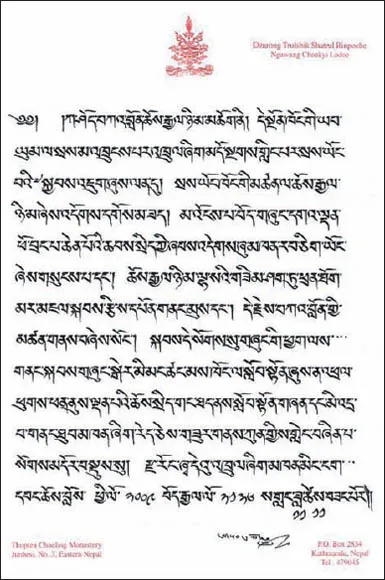![]()
Chapter 1
The Tibet of Kashopa’s Early Years
I will start Kashopa’s story with letters about him written by two eminent lamas, whom we refer to as Rinpoches or “Precious Ones”, one from the Nyingma and the other from the Gelug school of Tibetan Buddhism. I include them here for Pala dampa to rest in peace with Their Eminences’ blessings.
His Holiness the Dalai Lama and His Eminence Kyabje Trulshik Rinpoche
The first is a letter written in 2009 by His Eminence Kyabje Trulshik Rinpoche, one of the late tutors of His Holiness the Dalai Lama, about Kasho Choegyal Nyima:
“At the time when the parents of the Honourable Kalon Kasho Choegyal Nyima were without a son, they asked Trulshik Thongak Lingpa to pray that they might have one. He replied that they would indeed have a son, and that they should name their newborn boy Choegyal Nyima, and that in the future he would become a great servant of the Gaden Phodrang government. I personally met Choegyal Nyima at his Lhasa Simshak for the first time when he was a Tsipon and then I soon saw him take up the post of Kalon. At that time, and later on, while he was carrying out his government duties, all fair – minded people, both government officials and ordinary people, were saying that he [Kashopa] was someone who could offer unrivalled advice that is effective and beneficial for both the short and the long term, whether be it on religious or secular issues.
(Signed by) Dzarong Shatrul
Trulshik called Ngawang
Choekyi Lodoe in 2009 on the
11th day of the 11th month of
2136, the Tibetan
Earth-Bull Year.”
The second letter, dated 2009, is from His Eminence the Gaden Tripa Rizong Sras Rinpoche, who was then the Jangtse Choeje title holder. The Gaden Tripa, the holder of the ecclesiastical throne of the great monastery of Gaden, is the lineal successor of Tsongkhapa, the founder of the Gelug school in the 15th century. He is the most senior of the ordinary non-incarnate lamas and monks in the Gelug school, and occupies the third place in the hierarchical precedence of Tibet. On the two occasions when the 13th Dalai Lama went into exile twice, he appointed the then Gaden Tripas as Regents to rule over the country in his absence. This is what Rizong Rinpoche wrote about my father:
“In 1946, when I arrived in Lhasa, the Honourable Kashopa Choegyal Nyima was working as a Council Minister, though I don’t know how long he had held this post at that point. At that time, a group of us were able to attend more than two years of teachings by my glorious teacher, the 94th Gaden throne holder (Tri Rinpoche), His Eminence Lhundrup Zundru, on the Four Notes on the Great Treatise of the Path to Enlightenment and several other holy scriptures. Within the group were the Venerable Ngulchu Dharma Bhadra Rinpoche from Tashi Lhunpo Monastery, who later became the tutor of the Panchen Lama; some of the staff from Tashi Lhunpo Monastery; the Venerable Lamrimpa Phuntsok Palden from Sera Jey Monastery; and the Venerable Thapkhai, who was later to become the Abbot of Sera Jey Monastery during the uprising in 1959. We were all exceedingly grateful to Kashopa, who had facilitated us receiving such teachings by very generously lending my teacher several rooms in his house. I personally spent almost all my time attending the teachings at the Simshak (of Kashopa).
During the Sera War, when the government’s army planned to destroy the Sera Jey Monastery, the Honourable Choegyal Nyima skilfully made a pretext of volunteering to lead the army to save all of the monastery’s property. Regarding the issue of safeguarding the Sera Jey Monastery from being destroyed: one day, during the time when the Venerable Tri Rinpoche was giving teachings to us, I personally heard Kashopa tell Rinpoche on the balcony of the house that he had volunteered to lead the government army in order to prevent them from destroying the monastery and to ensure that the monastery would be left intact. He told Rinpoche to rest assured and not to worry. Rinpoche appreciated this very much and thanked Kashopa. We witnessed this ourselves.
The ex-Abbot of Sera Jey, the Venerable Champa Thegchok, mentioned that (the story about) Kashopa donating a new gold gilded copper roof for the Tamdrin Temple was true. I also heard that Kashopa helped and supported the ex-regent Reting when he received an indication of impending doom. It is also true what Palden Gyatso, the monk from Drepung Tsawa Khamtsen, from Tsang Penag Gadong, said about Kashopa importing a very good quality large cauldron from India and offering it to Drepung Loseling College. In short, I would like to give evidence, that in general, Kashopa was recognised by most people as both a religious man and a good politician.
Written and signed by the current
Jangtse Choeje title holder,
Rizong Sras Trul Thupten Nyima
on August 27th, 2009.”
Kashopa’s story: a starting point
Kashopa’s service to the Dalai Lamas began with the 13th Dalai Lama in the 1910s and ended with the departure of the 14th Dalai Lama from Tibet in 1959. First I’ll try to provide some background to Kashopa’s story. This is not only what I heard from Pala but also things that I learned from historians, so, like a parrot imitating human speech, I’ll repeat their words.
Tibet traditionally comprises three main regions, which are known in Tibetan as the Chol-kha-sum . They consist of U-Tsang, which includes central and western Tibet, extending from Ngari Korsum in the west to Sokla Kyawo in the east; Kham (also referred to as Dotoe ) which comprises eastern Tibet, from Sokla Kyawo to the upper bend in the Machu or Yellow River ; and Amdo (also called Domey ) or north-eastern Tibet, from the bend in the Machu to Chorten Karpo According to a saying in Tibetan, “U-Tsang is the region of devout people; Dotoe is the region of bravemen; Domey is the region of fine horses. .”5 On the fifth day of the fourth month of the Water-Horse year, corresponding to 1642, the 5th Dalai Lama, Ngawang Lobsang Gyatso, was enthroned in Shigatse by the Mongol chieftain Gushri Khan, who sat on a lower throne from which he offered the Dalai Lama the mendrel tensum. This is an auspicious symbolic offering, consisting of a gold image of the Buddha, a book of scriptures, and a small chorten or stupa (a reliquary), representing the body, the speech, and the mind of the Buddha. Gushri Khan then announced that he had conferred on the Dalai Lama supreme authority over all Tibet from Tachienlu in the far east (now known as Kangding in Sichuan province) up to the Ladakh border in the west. Since then the successive Dalai Lamas came to be the temporal and spiritual leaders of Tibet.
A month later, the Dalai Lama made a proclamation in Drepung Monastery declaring that Lhasa would be the capital of Tibet and that the dual religious and temporal form of government would be known as Gaden Phodrang, which was the name of his residence at Drepung. From then on, the Dalai Lama promulgated laws, appointed governors to different districts, and chose ministers for the Gaden Phodrang government, and ruled over the whole of Tibet.6
In 1912, some 250 years later, the 13th Dalai Lama returned from exile in India following an invasion two years earlier by troops belonging to the Qing emperor. Once back in Lhasa, he formulated policies that attached great importance to the training and upbringing of decent, well-educated officials and began to promote officials on the basis of their ability and loyalty to the government. People like Dasang Damdul (Tsarong, my elder brother’s father-in-law), who was not even an aristocrat, and Trimön (whom Lungshar would plot to assassinate) who was from a lower-status aristocratic family, were promoted to be commander-in-chief and deputy commander-in-chief of the army respectively. Later, both men were made Kalons—council ministers. Besides promoting these people who had provided outstanding service, The 13th Dalai Lama paid close attention to fighting corruption and the practice of bribery in government. He also promoted talented, honest and upright officials to important government posts. It was through these moves that the efficiency of the administration was greatly improved, as it allowed more capable officials to utilise their abilities to the full in public service instead of self-aggrandisement.
The 13th Dalai Lama attached great importance to British-style education. He developed a good relationship with the British Government, and with their support he sent four Tibetan students to England in 1913 to receive a Western education. As a result, electrical engineering and telegraphy were introduced for the first time to Tibet. Later, he again approached the British Government for help in establishing an English school in Gyantse, near the Kasho estate.7
From 1912 until 1933, during the reign of the 13th Dalai Lama, a new mint (called the Sertram) was first established near the Norbulingka Palace, and in 1917, for the first time gold coins were introduced to Tibet. A little later, copper coins also went into circulation. Then in 1931, His Holiness opened a new government department called the Drapchi Lekhung.8 It was located just north of Lhasa and was powered by a hydro-electrical plant. This was a large complex of buildings, including not only a modern mint for the production of paper currency, silver and copper coins, and postage stamps, but also an arsenal and a building for the manufacture of rifles and ammunition. The 13th Dalai Lama strengthened Tibet’s defence capability and imported equipment that the country itself could not produce. Tibet’s newly formed battalions were numbered according to the Tibetan alphabet— Ka (1), Kha (2), Ga (3), Nga (4) and Cha (5)—and the head of each battalion also used the letter in their title. So, for example, General Tethong, who was in charge of the Ga battalion, was called the Gadang Dapon, or the General of the Ga regiment. The 13th Dalai Lama advocated diligence and frugality in the lives of his officials. He also paid close attention to the economy. The result was that Tibet at the time, from 1912 until the 1940s, enjoyed a period of political stability and prosperity. Government officials at every level were restrained by strict rules and regulations and there was even a limit imposed on the amount of jewellery their wives could wear.
In traditional Tibetan society, there was a strict social hierarchy. At the top were the aristocrats and the highest among them were around thirty aristocratic families called Depon Midrag or Depon Che-khag. The Depons were the most prominent aristocrats who were the descendants of the Dalai Lamas and ancient kings, and they owned large estates; Midrag or Che-khag were the families of council members or Kalons. Below them was the largest group of lower-status aristocrats. They belonged to a class consisting of about a hundred and seventy families and were called Gerpa. These were normally landlords of variously sized estates rented out to tenants. The Depon Midrag and Gerpa were required to have at least one male family member available to serve the government on behalf of their estate, as it was given in return for serving the government.
As Pala was intended to be a government official, Grandmother attached great importance to educating him to the best of her ability. She did this while at the same time having to deal with the tremendous difficulties of running the estate by herself. She was a strong-minded, religious and kind-hearted woman but also a strict mother. For example she did not hesitate to beat Kashopa once when she ...
























